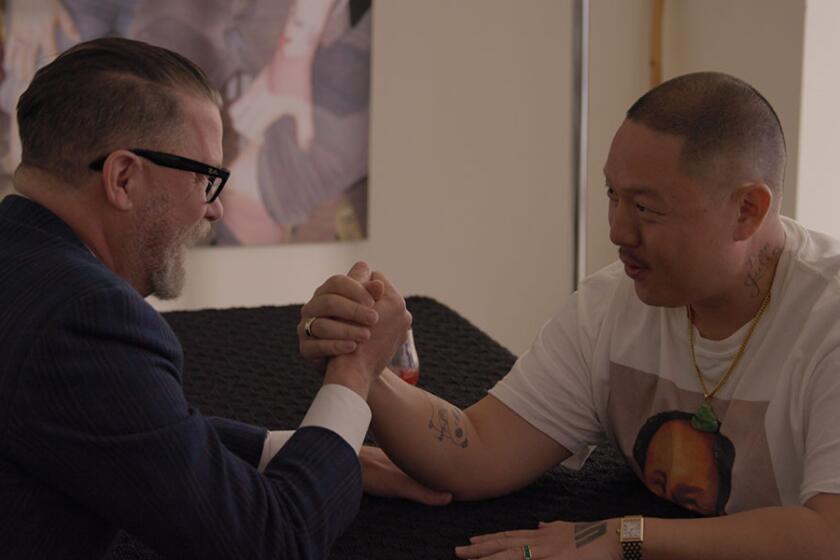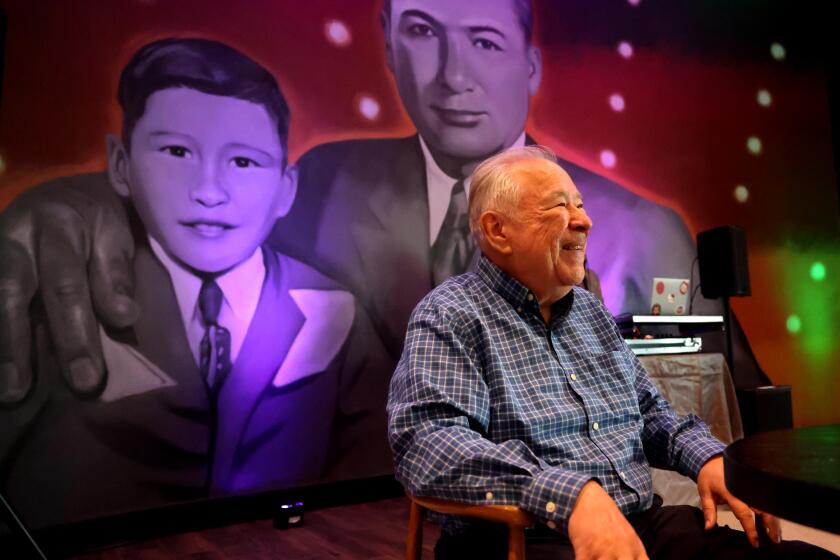Martini Time In The Garden of Allah
In the early 1940s, an exquisite blond actress, her handsome writer-husband and their skinny daughter were living at the Garden of Allah on Sunset Boulevard. The creation of silent-screen star Alla Nazimova, the Garden--tropical fruit trees and whitewashed bungalows around a pool shaped like the Black Sea--was like a movie set of a Moroccan village. One half-expected Humphrey Bogart and Lauren Bacall to come strolling along arm in arm--which, in fact, they often did.
The small apartments, called villas, were rented by the day, the week or the month to people in show business. Refugees from New York, lovers on trysts, artists in a dry spell or people on their way up or down found sanctuary. (Asked why he was staying there, George S. Kaufman once replied, “It reminds me of Hollywood.”) Some of the guests, such as Clifford Odets and Frank Sinatra, kept to themselves. But the actress in Villa 12 pulled those around her into a lively compound.
Natalie Schafer (20 years later she’d portray Lovey Howell on “Gilligan’s Island”) was living in a villa next door to her former husband, the actor Louis Calhern, who was living with Dorothy Gish. (Calhern was working on “Heaven Can Wait” and Gish on “Our Hearts Were Young and Gay.”) Schafer would traipse in, showing off half a dozen new hats from Bullock’s Wilshire. John Carradine might stagger over for a cup of sugar, or was it sherry?
At martini time, Robert Benchley (cherubic comedian and humorist), actor Charles Butterworth (his pal next door) and the actress would sit in Benchley’s living room with the door open and listen to Benny Goodman, Artie Shaw or Woody Herman noodling across the way.
The actress--the compound’s den mother--was Gloria Stuart, and her husband was the writer Arthur Sheekman. The skinny kid was me.
*
BETWEEN 1932 AND 1939, MY MOTHER MADE 41 MOVIES and my father worked on 11. Exhausted, they stashed me with my grandmother in Santa Monica and went around the world for nine months, ending up in New York (where I rejoined them) for a fling in the theater. Returning to Hollywood in 1943, Ma called friends to come to dinner even before she had unpacked. A woman of extraordinary energy and gifts, the actress in her was anxious to see and be seen, the artist in her was frantic for self-expression, the wife in her aimed at reconnecting connections, and the friend in her was eager to be near those she loved. Ma was--and is--a tireless friend, making phone calls, scribbling mash notes, sending keepsakes and stewing up “Chicken in the Pot” for the sick. Cooking and entertaining filled her needs.
Gas, sugar, flour, meat, fish, cheese, fats and canned goods were rationed, but the war effort only heightened her resourcefulness. Guests’ coupons in hand, off she’d go to the Farmers Market on Fairfax, where she cultivated her butcher, poultryman, produce lady, liquor guy and fancy grocers with plenty of smiles, inquiries after children and gifts at Christmas.
Dinner parties were my mother’s bailiwick. My father, on the other hand, was a shy man, happiest in his bedroom with his pad of yellow paper, soft-lead pencil and books. His contribution to a party was showing up and being amusing--Groucho Marx, who brought Daddy to Hollywood and was his best friend, called him the “fastest wit in the West.”
“Groucho was our social mentor,” Ma says. He collected people and shared them generously. And although he didn’t think much of actors, preferring the company of writers, he was nuts about my mother, calling her “a great broad.”
Everyone contributed to conversation over drinks and dinner, but afterward it became a meritocracy of smarts where the fastest, funniest and brightest held sway. It was tough to compete with the likes of Groucho and Harpo Marx, comedy writers Irving Brecher (“Go West”), Don Hartman (Hope/Crosby/Lamour “Road” pictures), Nat Perrin (“Hellzapoppin’ ”) and Harry Tugend (“Let’s Face It”), plus droll wits such as Nunnally Johnson (“The Grapes of Wrath”), Julius Epstein (“Casablanca”) and Albert Hackett (“The Thin Man”).
But the meritocracy was for men only. Most of them, born around the turn of the century, were raised with the notion that women had their place: Men talked, women listened. Once in a while, when someone was telling a story and his wife said, “Honey, I . . . .” she’d get a signal and hush.
The remarkable, Vassar-educated Frances Goodrich collaborated with her husband, Albert Hackett, but she spoke softly and rarely. Even the brilliant Dorothy Parker and Ethel Butterworth only zinged zingers at the end of stories, forgoing a full performance. Ma says the exception to the rule was Lillian Hellman: “She was so prestigious, the men deferred to her.”
*
THERE WEREN’T ONLY SHOUTS OF LAUGHTER AT SHEEKMAN parties. Everyone was a liberal and some were sympathetic to Communism (of course, Russia was our ally at the time). It was the degree of sympathy that could be troubling. Sometimes I’d be in bed, frightened at the anger raging in the next room. Dalton Trumbo (“Thirty Seconds Over Tokyo”), Adrian Scott (“Murder, My Sweet”), Hy Kraft (“Cafe Crown”) and Yip (E.Y.) Harburg (“Cabin in the Sky”) were passionate believers. Sometimes even tolerant friends like my father lost patience. At other times I would lie in bed and listen to marvelous music from our saloon piano. Lyricist Harry Ruby would sing “Three Little Words” and “Who’s Sorry Now?” or Groucho would sing Harry’s “Hooray for Captain Spaulding” and “Father’s Day.” Composer Arthur Schwartz would sing “Dancing in the Dark” or “They’re Either Too Young or Too Old.” Yip Harburg might calm down long enough to sing his lyrics from “Over the Rainbow.”
At times everyone played “The Game”--charades. There was lots of hollering with that. Women and men were equal when playing. (A young friend once asked, “What made these parties fun for the women, all things considered?” Ma answered, “It was what we were used to. Besides, the stories were the most hilarious, the music was the most exciting, even the arguments were fascinating.”)
Ma was crazy about the man-woman thing and loved cooking for people in love. The first time our old friend Humphrey Bogart brought over Lauren Bacall, Ma’s hostess book notes that she served chicken pot pie, panache de legumes, prunes and apricots en brochette, parsley and garlic French bread, guacamole and tortillas, Chateau Lejon, tartelettes et meringues and cafe au rhum. Ma’s style was--and is--unique.
Happy to be the center of attention, my mother loved to startle her guests, staggering in with great tubs of stews . . . a school of mountain trout in aspic . . . a 26-boy rijsttafel (an Indonesian feast) . . . flaming anything. The more flamboyant, the better.
Cooking for writers could bring special rewards. Samuel Hoffenstein, writing the screenplay for “Laura” with his truelove, Betty Reinhardt, composed a poem to Ma’s “Goose with Kirschwasser Aspic.” New Yorker contributor John McNulty sent a tongue-in-cheek review, set in the magazine’s type, of the dinner she’d made him. Ma’s close friend from college days, M.F.K. Fisher, was living in Hemet, writing “The Gastronomical Me.” Ma often drove out with baskets of provisions and notebooks of poetry or her novel-in-progress, and she and M.F. would read aloud and cook and sip for days. When M.F. came to town, she dined at Villa 12. She opened a chapter of the book with, “I know a beautiful honey-colored actress . . . .” and described Ma’s table as “. . . crowded with flowers, glasses, dishes of nuts, bowls of Armenian jelly and Russian relishes and Indian chutney, and beer and wine and even water . . . .”
Ma’s dining table was on a dais at the end of the living room, and the kitchen next to it wasn’t much bigger than the table. It had a square four-burner stove, a sink and small refrigerator; two packages of Birds Eye Frosted Foods barely fit above the ice trays. When cooking something elaborate for a party, Ma used all of her friends’ stoves and refrigerators, “even if they weren’t invited.”
In those days, Ma had a temper, and she tippled as she cooked. “I was always running back and forth in the kitchen,” she says, and sometimes things got knocked over. Once it was the whole pot of lamb shanks and dumplings. All that meat! Nothing for it but to scoop it up and go forward.
Here is a menu for a dinner Ma served during the holidays in 1944: lettuce salad, stuffed shoulder of veal gourmet, veloute sauce, French peas with mushrooms, noodles with buttered crumbs, Napa Gamay Rose and poires flambees.
A few notes: The salad recipe calls for iceberg lettuce because that’s what was available during the war. The spoon-tender veal, sauce and pears can be cooked well in advance and reheated. And while Ma prized her copper chafing dish for flaming, you won’t need one.
A bit of history about the wine: “Napa Gamay” was a California term for a strain of grapes thought to have come from Beaujolais (Gamay grapes are the heart of Beaujolais wine). Louis M. Martini used the Napa Gamay grapes to produce his lovely rose, but the wine no longer is made because that vineyard was sold years ago. It turns out that Beringer bought the vineyard, and currently it makes a Gamay Beaujolais from grapes grown at North Coast vineyards. The grapes used in this wine have been identified as a clone of Pinot Noir that is now called Valdiguie. So to recapture the flavor of a ‘40s Napa Gamay Rose, find a rose from Valdiguie grapes and serve it chilled. Salut.
The Wartime Kitchen
Stuffed Shoulder of Veal Gourmet
(Adapted from a recipe by June Platt)
Serves 8
3 pounds boned veal shoulder, trimmed of fat
1 1/2 pounds veal shank knucklebones
1/2 cup butter
3/4 cup yellow onion, finely chopped
1 garlic clove, minced
1/2 pound ham, cut into 1/2-inch pieces
1 cup fresh bread crumbs (white home-style bread, no crusts), size of rice grains
1/2 cup roasted pistachio nuts, chopped
1/2 pound calf’s liver, pulsed briefly in food processor
1 egg, beaten
1 tablespoon fresh sage leaves, finely chopped (1 teaspoon crumbled dried leaves)
1 teaspoon salt
1/2 teaspoon white pepper, freshly ground
1 (750 ml) bottle dry white wine
6 sprigs parsley
2 carrots, unpeeled and thinly sliced
Small bunch sage or parsley, for garnish
Make pocket for stuffing by cutting horizontally through shoulder, leaving 1/2-inch border around 3 sides. Wrap in plastic and refrigerate. Make braising stock by placing veal shank knucklebones and 2 quarts cold water in 4-quart sauceman. Cover loosely and simmer until reduced to 1 quart, about 2 hours. Skim fat and strain. Remove shoulder from refrigerator.
To prepare stuffing, melt 1/4 cup butter in large, heavy skillet over low heat. Add onions and garlic and stir occasionally until gilded, about 10 minutes. Remove from heat and mix in ham, bread crumbs, pistachios, liver, egg, sage, salt and pepper. With your hand, tuck stuffing into corners of shoulder, then fill pocket evenly. Close securely with thin metal skewers.
In 8-quart stockpot, melt 1/4 cup butter over medium heat. Brown roast on all sides. In separate pot, bring stock and wine to simmer, then pour over meat. Add parsley, heap carrots on top and simmer, covered, for 3 hours, turning hourly, repositioning carrots. Meat will be very tender when pierced with fork.
Wrap meat tightly in foil, set in baking dish and warm in 325-degree oven. Using braising liquid, make veloute sauce.
*
Veloute Sauce
About 3 1/2 cups
Cooking Broth
braising liquid from above recipe, reduced to 4 cups
5 tablespoons butter
5 tablespoons flour
Salt and white pepper to taste
*
In 3-quart skillet, over low heat, melt butter. Whisk in flour and continue whisking 3 minutes. Whisk while slowly adding stock until smooth. Simmer 20 minutes, whisking frequently until thickened. Pass through fine sieve and season to taste. To serve, remove skewers and trim ragged edges from meat. Place on heated platter, garnish with sage or parsley leaves. Slice portions 3/8-inch thick, holding pancake turner against roast to keep slice intact (if stuffing separates from meat, just pat it back together). Pass sauce separately. Stuffed shoulder is equally delicious served cold with aspic.
After meat has cooked, wrap in damp cheesecloth and set in deep bowl. Add broth and heap carrots on top of meat. Cover and refrigerate up to 3 days.
*
ASPIC
2 1/2 tablespoons unflavored gelatin
1/4 cup dry vermouth
4 cups broth, heated
*
Soften gelatin in vermouth. Whisk hot broth into gelatin gradually until smooth. Pour into 9-inch-by-13-inch baking dish. Cover and chill until set. Chop coarsely and surround sliced meat on platter.
*
French Peas With Mushrooms
Serves 6 to 8
6 tablespoons butter
1/2 pound small mushrooms, halved through stems
4 cups frozen large peas (1 pound)
1 cup frozen pearl onions (6 ounces)
1 1/2 cups shredded iceberg lettuce
1 teaspoon sugar
1/2 teaspoon salt
1/4 teaspoon white pepper, freshly grated
4 sprigs parsley, tied with cotton string
*
Melt 2 tablespoons butter in 9- to 10-inch skillet. Add mushrooms and saute over medium heat until lightly browned, stirring frequently, about 5 minutes. (This may be done an hour or so in advance.) Cover.
At serving time, melt 1/4 cup butter in broad 4-quart saucepan. Add peas, onions, lettuce, sugar, salt and pepper and stir until blended. Bury parsley in peas and cook uncovered over medium-high heat, stirring frequently until tender, about 10 minutes. Just before peas are ready, toss mushrooms in skillet over high heat until hot. Stir with juices into peas, remove parsley, taste for seasoning and serve at once in hot dish.
*
Noodles With Buttered Crumbs
(Adapted from a recipe by June Platt)
Serves 6 to 8
2 slices white home-style bread
1/2 cup butter
3/4 pound wide egg noodles
1/2 teaspoon salt, or to taste
1/4 teaspoon white pepper, freshly ground
*
Toast bread. Pulse in food processor to make 1 cup fluffy crumbs smaller than rice grains. Melt butter in medium skillet, add crumbs and stir constantly over moderate heat until browned. This may be done several hours in advance.
Just before serving, cook noodles according to package directions, meanwhile heating crumbs. Drain noodles, turn into heated serving bowl, add salt, pepper and crumbs, mix thoroughly, taste for seasoning and serve.
*
Lettuce Salad
Serves 6
2 6-inch heads iceberg lettuce
Remove cores and any limp or discolored leaves. From center of each head cut 3 crosswise slices 1/2-inch thick. Stack, wrap airtight in plastic film and refrigerate until chilled, 3 to 8 hours. Serve on icy plates with dressing spooned evenly over tops.
*
French Dressing
(Adapted from a recipe by Louis Diat)
Serves 6
9 tablespoons olive oil (mild)
3 tablespoons cider vinegar
1 1/2 teaspoons dry mustard
Salt to taste
1/4 teaspoon black pepper, freshly ground
*
In half-pint jar, combine oil, vinegar, mustard, salt and pepper, cover tightly and shake. Taste for seasoning. Cover tightly and keep at room temperature. May be prepared up to 1 week in advance. Just before serving, shake until thoroughly blended.
*
Poires Flambees
Serves 6
6 Bosc pears with stems, slightly underripe
2 cups sugar
3/4 cup seedless raspberry jam
3/4 cup reserved poaching syrup
6 tablespoons maraschino or brandy
3/4 cup kirsch
1/3 cup almond slices or slivers, toasted
*
Peel pears, leaving stems. With apple corer or small sharp knife, remove cores from bottom halfway up. Trim bottoms as needed to stand upright. Drop pears into cold water to keep from browning.
For poaching syrup, place sugar in quart measuring container, add water to make 1 quart and stir until dissolved.
Pour into deep saucepan and bring to boil. Add pears and lay circle of parchment paper over pears to keep moist. Simmer until fruit flesh meets no resistance when pierced with thin skewer--test pears after 20 minutes. Cool in syrup under parchment, refrigerate same way up to 3 days. (Leftover strained poaching syrup may be frozen.)
To serve, drain pears (reserving 3/4-cup syrup) and set in deep 6-cup baking dish. In pint measuring pitcher whisk jam, syrup and maraschino until smooth, pour over pears. Cover with foil and bake at 325 degrees until bubbling, about 1 hour. Bring pears and warmed dessert bowls to table.
Quickly heat kirsch in small saucepan until bubbles form around edges. At table, light with match and pour flaming over pears, spooning sauce over pears until flames die. Serve pears and sauce sprinkled with almond slivers.
More to Read
Only good movies
Get the Indie Focus newsletter, Mark Olsen's weekly guide to the world of cinema.
You may occasionally receive promotional content from the Los Angeles Times.










